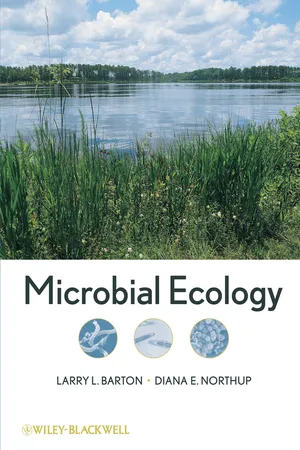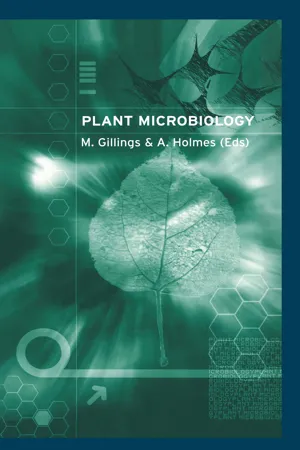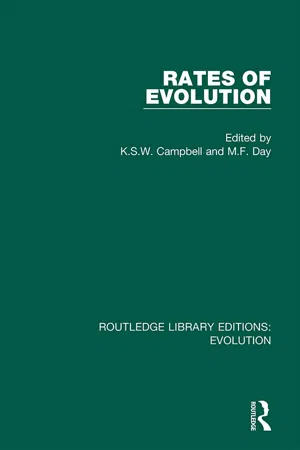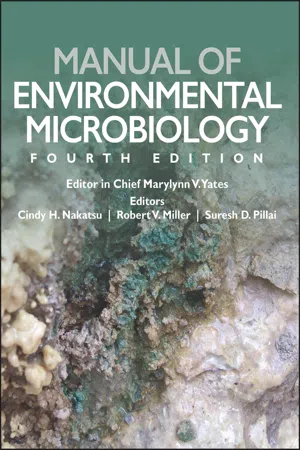Biological Sciences
Genetic Diversity in Prokaryotes
Genetic diversity in prokaryotes refers to the variation in genetic material within populations of bacteria and archaea. This diversity arises from mechanisms such as mutation, horizontal gene transfer, and genetic recombination. It plays a crucial role in the adaptation and evolution of prokaryotic organisms, allowing them to respond to environmental changes and challenges.
Written by Perlego with AI-assistance
Related key terms
Related key terms
1 of 4
Related key terms
1 of 3
4 Key excerpts on "Genetic Diversity in Prokaryotes"
- eBook - ePub
- Larry L. Barton, Diana E. Northup(Authors)
- 2011(Publication Date)
- Wiley-Blackwell(Publisher)
Hugenholtz P. 2002. Exploring prokaryotic diversity in the genomic era. Genome Biology 3:reviews 0003.1–0003.8. Hugenholtz P, Goebel BM, Pace NR (1998), Impact of culture-independent studies on the emerging phylogenetic view of bacterial diversity, J. Bacteriol. 180:4765–4774.Insall R (2005), The Dictyostelium genome: The private life of a social model revealed? Genome Biol. 6:article 222.Kimura M, Jia Z-J, Nakayama N, Asakawa S (2008), Ecology of viruses in soils: Past, present and future, Soil Sci. Plant Nutr. 54:1–32. Kneip C, Lockhart P, Vo ß C, Maier U-G (2007), BMC Evolut. Biol. 7:55. Konhauser K (2007), Introduction to Geomicrobiology, Malden, MA: Blackwell Publishing. Kröger N, Poulsen N (2008), Diatoms—from cell wall biogenesis to nanotechnology, Annu. Rev. Genetics 42:83–107. Madigan MT, Mrtinko JM, Dunlap PV, Clark DP (2009), Brock Biology of Microorganisms, 12th ed., San Francisco: Pearson Benjamin Cummings. Margulis L, Schwartz KV (1998), Five Kingdoms: An Illustrated Guide to the Phyla of Life on Earth, 3rd ed., New York: Freeman. Martin W, Koonin EV (2006), A positive definition of prokaryotes, Nature 442:868. Mendell JE, Clements KD, Choat JH, Angert ER (2008), Extreme polyploidy in a large bacterium, Proc. Natl. Acad. Sci. (USA) 105:6730–6734. Oren A (2006), The order Halobacteriales, in Dworkin M, Falkow S, eds., The Prokaryotes: A Handbook on the Biology of Bacteria, New York: Springer, pp. 113–164. Pace NR (2006), Time for a change, Nature 441:289. Parfrey LW, Barbero E, Lasser E, Dunthorn M, Bhattacharya D, Patterson DJ, Katz LA (2006), Evaluating support for the current classification of eukaryotic diversity, PLoS Genetics 2:2062–2072. Rappé MS, Giovannoni SJ (2003), The uncultured microbial majority, Annu. Rev. Microbiol. 57:369–394. Robertson CE, Harris JK, Spear JR, Pace NR (2005), Phylogenetic diversity and ecology of environmental Archaea, Curr. Opin. Microbiol. 8:638–642. - eBook - ePub
- Michael Gillings, Andrew Holmes(Authors)
- 2004(Publication Date)
- Taylor & Francis(Publisher)
10
Genetic diversity of bacterial plant pathogens
Mark Fegan and Chris HaywardPlant Microbiology, Michael Gillings and Andrew Holmes© 2004 Garland Science/BIOS Scientific Publishers, Abingdon.10.1 Introduction
The capacity to cause plant disease has evolved in a relatively small number of bacterial species which are phenotypically and genetically diverse. Below the level of the species the strains that make up these species also vary in genotype and phenotype. Traditionally phenotypic techniques such as substrate utilisation profiles and total fatty acid composition have been employed to characterise plant-pathogenic bacteria. Recently more reliable DNA-based methods have been applied which provide a more complete understanding of genetic and evolutionary relationships of bacteria.The genetic diversity of phytopathogenic prokaryotes can be assessed by employing molecular methods which differ in the taxonomic level at which they can discriminate (Figure 10.1 ). The phylogenetic diversity of plant-pathogenic bacteria, primarily assessed by phylogenetic analysis of 16S rRNA gene sequences, is of primary importance in the description of bacterial species (Stackebrandt and Goebel, 1994). Another taxonomically important technique for the assessment of genetic diversity of bacteria is the estimation of total DNA-DNA homology. If two strains share 70% DNA-DNA homology they are considered to be related at the species level (Wayne et al., 1987). However, in the absence of differential phenotypic or chemotaxonomic characteristics between strains, which exhibit less than 70% DNA-DNA homology, genomic species or genomospecies have been defined instead of a new species being described (Schloter et al., 2000).The basic premise for the assessment of the genetic diversity of any organism is to establish a taxonomic structure from which a nomenclature and classification system for the organism can be generated. The classification system thus generated can then be used to identify the organism and facilitate the prediction of the properties of new isolates, which will hopefully, in the case of plant pathogens, include plant pathogenicity. This improved taxonomy of plant-pathogenic bacteria aids in the development of targeted diagnostic tests, permits the definition of subspecific groups for use in the development of quarantine regulations and is useful in the study of the epidemiology and ecology of the organisms and the study of population genetics and evolution. - eBook - ePub
- K.S.W Campbell, M.F. Day(Authors)
- 2019(Publication Date)
- Routledge(Publisher)
13The origin, nature and significance of genetic variation in prokaryotes and eukaryotesD. C. REANNEY
ABSTRACT
This chapter is based on the premise that natural selection acted to minimise the deleterious effects of (expressed) genetic errors during the early phases of evolution, when many familiar features of the genetic apparatus were ‘fixed’. According to this thesis many key features of the information- transmitting system of cells may be viewed as adaptive responses to the heavy error load placed on early genomes by their inability to correct errors made during copying or introduced from the environment. These features include;(1) diploidy and reciprocal recombination in eukaryotes;(2) genome segmentation among RNA viruses and;(3) the processing system which excises introns from RNA precursors.INTRODUCTION
The title of this chapter is something of a misnomer. I am less concerned with the origin and nature of genetic variation than with its significance for evolution. Let me start by showing how sloppy use of language unconsciously shapes our ideas, often to the detriment of the facts. Compare the words ‘variation’ and ‘error’. In the context of genetics, both usually refer to mutations in DNA (or RNA), that is, they refer to the same thing. But the mental images they evoke are quite different: variation somehow implies ‘useful change’ it links with the notion that mutation is a ‘good’ thing because it fuels evolution. By contrast error implies ‘malfunction — it links with the idea that mutation is a ‘bad’ thing because it causes information to decay. This confusion of meanings must be avoided. The hard fact is that although mutations may cause genomes to ‘vary’ they almost always do so in a destructive - eBook - ePub
- Cindy H. Nakatsu, Robert V. Miller, Suresh D. Pillai(Authors)
- 2016(Publication Date)
- ASM Press(Publisher)
17 ). Collectively, the standing genetic and phenotypic variation found in microbial communities provides a plethora of materials for ecological and evolutionary processes to act on.2. Microbes have high evolutionary potential : Owing to their large population sizes and short generation times, microorganisms have the potential to evolve much faster than plants and animals. In addition, microbes tend to live in close proximity with one another (e.g., biofilms), which allows them to share resources and by-products and establish coevolved, syntrophic interactions (18 ). In theory, the lack of sexual reproduction should dramatically reduce rates of evolution in species with finite population sizes, since sex, through recombination, accelerates the rate at which multiple favorable mutations emerge within a genome (19 ). However, homologous recombination occurs within and between microbial populations (20 , 21 ) and microorganisms can acquire novel sources of genetic information through horizontal gene transfer (22 ). Even at low frequencies, the vast population size of microbes ensures that such mechanisms, in combination with mutation, generate large reservoirs of diversity for evolutionary processes to act on.3. Microbes are model systems for studying evolutionary ecology : Compared with “macrobial” systems, microorganisms have unique features that can readily be harnessed for studying evolutionary ecology (23 ). With microorganisms, one does not typically need to be concerned about small population sizes, which can be important when making inferences about evolutionary processes. Moreover, many of the taxa that are used in laboratory settings have fairly short generation times, which is a requisite for studying evolution in action. Although great progress has been made in evolutionary ecology by studying model organisms (e.g., Escherichia coli , Pseudomonas aeruginosa , and Bacillus subtilis ), an increasing number of microorganisms can be isolated from the natural environment and maintained under laboratory conditions (24 ,25 ). In some cases, these microbes are amenable to genetic manipulation, which means that scientists can explore the genetic underpinnings of phenotypic traits using molecular tools such as recombineering. In microbial systems where genetic manipulations are not feasible, scientists are taking advantage of advances in genomics, transcriptomics, proteomics, and metabolomics to explore the eco-evolutionary complexities of microbial communities (26 –28
Index pages curate the most relevant extracts from our library of academic textbooks. They’ve been created using an in-house natural language model (NLM), each adding context and meaning to key research topics.
Explore more topic indexes
Explore more topic indexes
1 of 6
Explore more topic indexes
1 of 4



